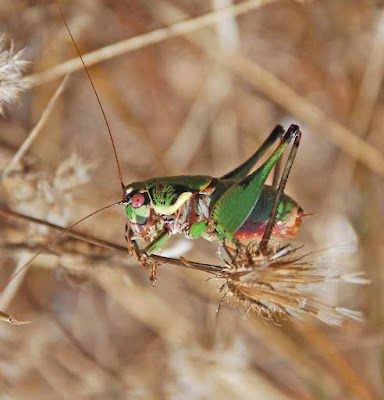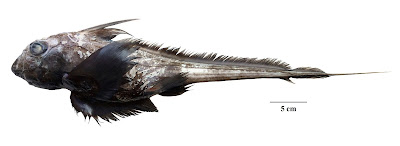[Most Recent Entries] [Calendar View]
Saturday, March 9th, 2024
| Time | Event | ||||
| 3:00a | [Entomology • 2024] Eupholidoptera kekrops • A New Bush-cricket Species (Orthoptera: Tettigoniidae) from Greece
Abstract Eupholidoptera kekrops sp. nov. belonging to the E. prasina group, is described from mainland Greece. The new species is the first known member of this group from mainland Greece and mainland Europe. Differentiating morphological characteristics, mainly of the subgenital plate and titilator, are presented. Keywords: Attiki, Eupholidoptera prasina group, new species, taxonomy
Family Tettigoniidae Krauss, 1902 Subfamily Tettigoniinae Riek, 1952 Tribe Decticini Herman, 1874 Genus Eupholidoptera Mařan, 1953 Eupholidoptera kekrops sp. nov. Diagnosis: The new species is well defined in morphological terms and easily recognizable. The absence of a tooth at the cerci of the male place it within the E. prasina group (Ҫiplak et al. 2009, 2010). The species of this group are distributed in the Aegean islands as well as west and south Anatolia, usually having a very restricted distribution (Ҫiplak et al. 2010). Distribution.— Known only from Greece, East Sterea Ellas (Attiki: eastern slopes of Mt. Imittos and the area of Vravrona). Etymology.— The new species is named after Kekrops (Cecrops), Κέκρωψ, the mythical first king of Attiki and founder of the city of Athens. Sotiris Alexiou. 2024. Eupholidoptera kekrops sp. nov. (Orthoptera, Tettigoniidae), New Bush-cricket from Greece. Journal of Orthoptera Research. 33(1): 67-70. DOI: 10.3897/jor.33.103790 | ||||
| 3:40a | [Herpetology • 2024] Calotes iadina & C. yunnanensis • Systematic Revision of the Calotes jerdoni complex (Squamata: Agamidae) in the Pan-Himalaya
Abstract Owing to the harsh terrain, few biodiversity surveys have been carried out in the Pan-Himalaya Region. Among the understudied taxa from this region, Jerdon’s forest lizard, Calotes jerdoni, is believed to have a wide distribution, from northeast India to southwestern China. However, given the heterogeneous environment across its range and the lack of studies on this species, its taxonomy remains questionable. Using integrative taxonomic methods, we combined both morphological and genetic data from the type and topotypic specimens and examined the current taxonomic hypothesis of C. jerdoni across its range. Molecular data reveal that C. jerdoni as currently recognized, contains three deeply diverged lineages: one from the type locality in Northeast India, one from Western Myanmar, and another one from Southwestern China. The uncorrected genetic distances of mitochondrial coding gene ND2 among these three clades ranged over 10%. The Chinese population is sister to C. medogensis and paraphyletic to the remaining two clades of C. jerdoni. Morphological analyses confirm the results of the molecular analyses, where the Myanmar and Chinese populations can be diagnosed statistically in both univariate and multivariate space from the true C. jerdoni, as well as by a suite of reliable categorical morphological characters, including the size and shape of gular scales and ventral scales. To resolve the current taxonomic confusion, we resurrect the junior synonym, C. yunnanensis, for the Chinese population and expand its distribution to Myanmar, redescribe the elusive C. maria and C. medogensis based on its type material, and describe the remaining western Myanmar population as a new species. We further discuss the possibility of additional cryptic species within the complex in the Pan-Himalaya Region and provide a diagnostic key to all recognized members of the C. jerdoni complex. Keywords: Dragon lizards, East Himalaya, questionable records, taxonomic revision, Tibet, Xizang Autonomous Region
Calotes iadina Wang, Deepak & Grismer, sp. nov. Diagnosis: Calotes iadina sp. nov. can be diagnosed by a combination of the following morphological characters: (1) body size large, SVL 63.2–102.5 mm; (2) tail slender, long, TAL 293.9–367.9% SVL; (3) conical scales of two parallel ridges triangular shaped, relatively low, not in spine shape; (4) inferior row of conical scales 2–3 scale rows away from superior tympanum, TRD 14.8–28.8% TD; (5) mental larger than first pair of chin shields; (6) gular scale count 16–19, much larger than ventrals, strongly keeled, mucronate, each bearding a distinctively elongated tip on posterior end; (7) gular pouch feeble or absent, transverse gular fold absent; (8) shoulder fold present, covered with granular scales underneath; (9) nuchal crests relatively short, lanceolate shape, TNC 8.27–13.3% HL, dorsal crests moderately developed; (10) neck scales oriented ... Etymology: The species name iadina is derived from Greek, which means “emerald” and refers to the bright green coloration of the new species. Kai Wang, V. Deepak, Abhijit Das, L. Lee Grismer, Shuo Liu and Jing Che. 2024. Systematic Revision of the Calotes jerdoni complex (Reptilia: Squamata: Agamidae) in the Pan-Himalaya. Vertebrate Zoology. 74: 169-192. DOI: 10.3897/vz.74.e109088 | ||||
| 7:44a | [Botany • 2024] Primulina adenopoda (Gesneriaceae) • A New Species from the Limestone Karst Area of Jiangxi Province, China
Abstract Primulina adenopoda (Gesneriaceae) is described and illustrated here. This new species resembles P. yangshanensis W.B.Xu & B.Pan and P. depressa (Hook.f.) Mich.Möller & A.Weber in leaf blade shape, corolla tube shape, and corolla color; phylogenetic analysis shows it is closely related them too, but it is distinct from them by indumentum characters, bracts number, corolla tube size, and placenta type. The conservation status of P. adenopoda is assessed as "Near Threatened" (NT) according to IUCN Red List Categories and Criteria. Keyword: Flora of Jiangxi, IUCN, Primulina depressa, Primulina yangshanensis, Taxonomy, Yushiyan Scenic Spot
Primulina adenopoda G.L.Xu, sp. nov. Diagnosis: Primulina adenopoda are similar to P. yangshanensis and P. depressa morphologically. However, it can be easily distinguished from P. yangshanensis by its corolla tube 3.7–4.1 cm long, with a yellowish-brown mark between two adaxial lobes inside (vs. 1.4–1.7 cm long, without mark in P. yangshanensis, following order same); bracts 3 (vs. 2); filaments sparsely glandular-puberulent (vs. glabrous). It differs from P. depressa (Hance, 1883; Wang et al., 1990, 1998; Li and Wang, 2005; Weber et al., 2011) by parietal placenta (vs. axile placenta in P. depressa, following order same); bracts 3 (vs. 2); filaments sparsely glandular-puberulent (vs. glabrous). Etymology: The petiole of this new species covered with dense pubescence and intermixed with glandularpubescence, so the specific epithet is derived from the indumentum characters of petiole, namely "adenopoda". Vernacular name: 腺柄报春苣苔 (Chinese name); Xiàn Bǐng Bào Chūn Jù Tái (Chinese pronunciation). Di-Ya Chen, Xiao-Hui Zeng, Wei-Long Cai, Xiao-Gang Wu, You-Ying Gao and Guo-Liang Xu. 2024. Primulina adenopoda (Gesneriaceae), A New Species from the Limestone Karst Area of Jiangxi Province, China. Taiwania. 69(1); 74-82. DOI: 10.6165/tai.2024.69.74 | ||||
| 7:44a | [Ichthyology • 2023] Moenkhausia iris • A New colorful Species of Moenkhausia (Characiformes: Characidae) from the upper rio Madeira Basin at the Chapada dos Parecis, Brazil, with comments on its conservation and putative biogeographic history
Abstract A new species, Moenkhausia iris, is described from the upper rio Madeira basin, Mato Grosso State, Brazil. The new species is unique among congeners by its color in life, which is the dorsal half of body blue or green and ventral half red, more intense above the anal fin. Additionally, it can be distinguished by having a single, vertically elongated humeral spot, a lateral surface of body, caudal peduncle, and anal fin without distinct blotches or oblique marks and 18–19 branched anal-fin rays. The new species is endemic from a small tributary of the Rio Guaporé, rio Madeira drainage at Chapada dos Parecis. Its putatively close relatives are endemic to the upper rio Juruena located at the same shield. Both headwaters are very close to each other, sharing other restricted range species, and their hydrogeological topography indicates the upper rio Juruena stretch was captured by the rio Guaporé through a headwater capture event. Moenkhausia iris is much appreciated in the international aquarium trade, as well as many other tetras endemic from the same area. Exportation is based on the capture of wild individuals so sustainable exploitation is necessary for its conservation. Keywords: endemism, Guaporé, headwater capture, ornamental fish trade, taxonomy Moenkhausia iris sp. nov. Etymology. The epithet iris, a feminine noun in apposition, means rainbow, referring to the colorful body of the species, containing the different colors of the rainbow. It is also an allusion to the vivid and multicolored iris of the species Manoela Maria Ferreira Marinho and Fernando César Paiva Dagosta. 2023. On A New colorful Species of Moenkhausia (Characiformes: Characidae) from the upper rio Madeira Basin at the Chapada dos Parecis, Brazil, with comments on its conservation and putative biogeographic history. Journal of Fish Biology. 103(5); 1122-1128. DOI: 10.1111/jfb.15513 | ||||
| 7:44a | [Ichthyology • 2024] Chimaera supapae (Holocephali: Chimaeriformes: Chimaeridae) • A New Species of Chimaera from the Andaman Sea of Thailand
Abstract A new species of shortnose chimaera is described from a single specimen collected at 772–775 m depth in the Andaman Sea (07.54° N; 96.99° E) off Thailand. The species is distinguished from its congeners by the combination of the following characteristics: massive head with short snout; eyes relatively large, horizontally oval, eye length 32.2% head length; thin body with a relatively long trunk 40% body length (BDL), deciduous skin; uniformly dark brown; preopercular and oral lateral line canals sharing a common branch; posterior margin of pectoral fins slightly convex; long dorsal spine 27% BDL, longer than the first dorsal fin. The new species is morphologically close to Chimaera macrospina from Australia but differs in the length of the ventral caudal lobe, snout-vent length, and pectoral fin anterior margin length. It can be distinguished from C. macrospina and other Chimaera species based on the DNA sequence divergence of the mitochondrial ND2 gene. Key words. Chondrichthyes, eastern Indian Ocean, SE Asia, morphology, genetics, taxonomy
Chimaera supapae, new species Andaman shortnose chimaera Diagnosis. Chimaera supapae can be distinguished from all other chimaeroids by the following combination of characters: massive head with a short snout; eyes relatively large, horizontally oval, eye length 32.2% head length; thin and relatively long trunk 40% BDL, deciduous skin; uniformly dark brown, without any spots or stripes; preopercular and oral lateral line canals sharing a common branch; posterior margin of pectoral fins slightly convex; long dorsal spine 27 % BDL, longer than first dorsal fin. Etymology. The epithet supapae is named to honor the late Professor Supap Monkolprasit (1934–2013), for her extensive work on the cartilaginous fishes of Thailand. She was the Dean of Faculty of Fisheries, Kasetsart University, Thailand during the years 1991–1995, but devoted her entire life to the study of cartilaginous fishes in Thailand. Distribution. Known only from the type location ___ in the Andaman Sea off Thailand, eastern Indian Ocean at 772–775 m depth (Fig. 1). |
| << Previous Day |
2024/03/09 [Calendar] |
Next Day >> |












